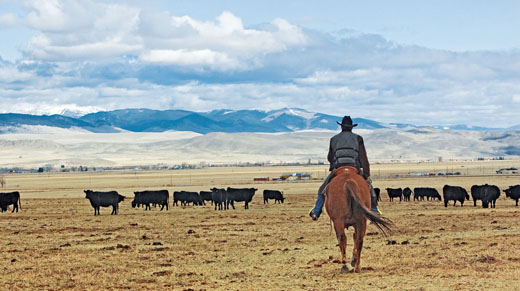Marinated Flank Steak
Flank steak, also known as London broil, isn’t the most tender cut of beef, but it is one of the most flavorful. The key to getting a tender flank steak is to let the meat marinate for a good, long time—in this case, in a mixture of red wine, Worcestershire sauce, garlic, various spices, and fresh rosemary—and then carve it across the grain into thin slices before serving.
1 tbsp. black peppercorns
1 tbsp. coriander seeds
1 tbsp. fennel seeds
2 dried chiles de árbol, broken
2 bay leaves
½ cup red wine
2 tbsp. red wine vinegar
2 tbsp. Worcestershire
4 cloves garlic, crushed
2 sprigs fresh rosemary
½ cup extra-virgin olive oil
1 2-lb. flank steak Kosher salt, to taste
Serves 4
1. Toast the peppercorns, coriander, fennel, chiles de árbol, and bay leaves in a small skillet over high heat, stirring occasionally, until fragrant, 2-3 minutes. Transfer the aromatics to a hard surface, lightly crush them with the bottom of a heavy skillet, then transfer them to a 9 x 13-inch baking dish.
2. Add the wine, vinegar, Worcestershire, garlic, rosemary, and olive oil to the baking dish and whisk to combine. Prick the steak all over with a fork, place it in the marinade and spoon some marinade over the top. Cover and refrigerate, turning occasionally, for at least 12 hours and up to 24 hours.
3. An hour before grilling, transfer the steak to a plate, season with salt, and set aside at room temperature. Transfer the marinade to a small pot and bring just to a boil; set aside.
4. Build a medium-hot fire in a charcoal grill or set a gas grill to medium-high heat. Grill the steak, turning once and, using a brush, basting with the reserved marinade occasionally, until browned and medium rare, 7-8 minutes per side. Transfer the steak to a cutting board, tent with foil, and let rest for about 10 minutes. Carve the steak into thin slices across the grain and serve with any accumulated juices.
A cowboy rides herd at La Cense ranch, an 88,000 acre grass-fed cattle operation in Dillon, Montana.
Is It Done Yet?
When it comes to cooking a steak, most restaurant cooks have the seemingly magical ability to take the meat off the heat at exactly the right moment. For most of us at home, however, learning to cook a steak to perfection is a process of trial and error. But take heart: you don’t need X-ray vision to divine the color of the inside of a thick steak; just some basic know-how. The same rules apply to all cuts, whether it’s a flavorful flank (like the one pictured) or a pricey porterhouse: steaks become firmer and lose their red color as they cook, proceeding from “blue” (nearly raw) to rare (deep red) to medium rare (deep pink) to medium (light pink) to medium well (gray with a hint of pink) to well-done (gray throughout). Many cooks agree that medium rare is usually the level that brings out a steak’s best qualities, in both flavor and texture. The most important thing to remember is that steaks cook fast (especially those from lean, grass-fed cattle). A meat thermometer usually isn’t a good option for gauging doneness, since it’s hard to get a reliable reading using most standard models. Also, following many published guidelines for judging doneness by temperature—including those issued by the USDA—will pretty much ensure that your steak is overcooked. Some cooks determine the doneness of a steak by checking firmness—an old rule says a rare steak should feel like the soft flesh between your thumb and forefinger. Others follow a ten-minutes-per-inch rule. But for our money—and when we’re shelling out for good meat, that’s not an inconsiderable factor—the single best solution is the tried-and-true “nick and peek” method. Make a small cut in the steak, take a look inside, and judge the color for yourself. Until you’ve confidently mastered your own method, though, err on the side of caution and remove the steak from the heat slightly before you think it has achieved its desired doneness; it will continue to cook as it rests. And keep in mind that with thicker steaks, lean cuts (like a filet mignon) cook faster than fattier ones (like a rib eye) and that the presence of a bone prolongs the cooking time.


